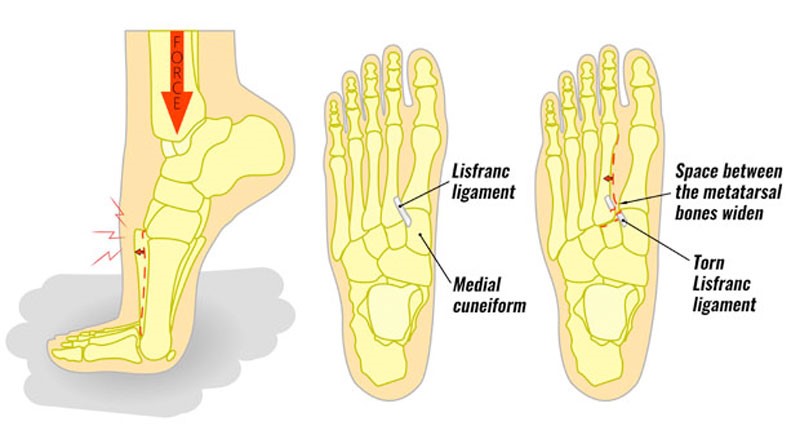Lis franc (midfoot) injuries result if bones in the midfoot are broken or ligaments that support the midfoot are torn. The severity of a Lis franc injury can vary widely — from a simple injury involving one midfoot joint to a complex injury involving many midfoot joints and broken bones.

Anatomy
The midfoot is the middle region of the foot, where a cluster of small bones forms the arch on the top of the foot. From this cluster, five long bones (metatarsals) extend to the toes.
The bones are held in place by strong ligaments, known as the Lis franc joint complex, that stretch both across and down the foot.
A twisting fall can break or shift (dislocate) these bones out of place.
The Lis franc midfoot joint complex has very litle motion and is critical in stabilizing the arch for push off during walking (gait). During walking, the midfoot transfers the forces generated by the calf muscles to the front of the foot. If a Lis franc injury is left untreated, instability of the arch can persist, resulting in the collapse or flattening of the foot.
Description
The midfoot will be affected if the bones are broken (fractured) or the ligaments are torn. Injuries can vary, from a simple injury that affects only a single joint to a complex injury that disrupts multiple different joints and includes multiple fractures
Lis franc injuries tend to damage the cartilage of the midfoot joints. Cartilage covers the ends of bones in the joints, allowing the joints to move smoothly. If severe midfoot injuries are not properly treated, damage to the cartilage and increased stress at the midfoot joints can result in arthritis and collapse of the arch, which requires complex surgery to correct. Even with successful surgery for the Lis franc injury, arthritis can still develop in later life.
Cause
A low-energy Lis franc injury can happen with a simple twist and fall. It is also commonly seen in football and soccer players when one player lands on the back of another player’s foot while the foot is flexed downward in the push-off position.
More severe injuries occur from direct trauma, such as a fall from a height or a motor vehicle collision. In these high-energy lisfranc injuries, multiple foot fractures and joint dislocations can occur, along with injuries to the back and other limbs.
Symptoms
These are the most common symptoms of Lis franc injury:
Imaging Tests
X-rays.
Broken bones and the position of the bones can be seen in an X-ray image. An X-ray also can show the alignment of the Lis franc joint.
Magnetic resonance imaging (MRI) scan
Subtle Lis franc injuries can be difficult to diagnose. MRI scans do a better job of imaging the soft tissues around the bone, including the ligaments that are injured in a Lis franc injury. This test is not required to diagnose a Lis franc injury, but it may be helpful in cases where the diagnosis is in doubt.
Computerized tomography scan (CT ) scan
CT scans are more detailed than X-rays and can create cross-section images and 3-D renderings of the injured foot. CT scan will help evaluate the exact extent of the injury and the number of joints involved.
Treatment
Treatment for a Lis franc injury depends on the severity of the injury.
Nonsurgical Treatment
If there are no fractures or dislocations in the joint and the ligaments are not completely torn, nonsurgical treatment may be all that is necessary for healing. A nonsurgical treatment plan includes wearing a non-weight bearing cast or boot for 6 to 8 weeks. You must be very strict about not putting weight on your injured foot during this period. This then progresses to weight bearing in a removable cast boot or an orthotic.
Surgical Treatment
Surgery is recommended for injuries with displaced fractures (broken bones) or with abnormal positioning (instability) of the joints. The goal of surgical treatment is to realign the joints, return the fractured bone fragments to a normal position, and restore stability to the midfoot.
These procedures can be used to treat Lis franc injuries
In operative procedure, position of the bones should made correctly (reduction), and one should secure the bones in place with plates or screws. Because the plates or scr


